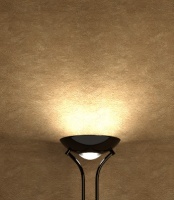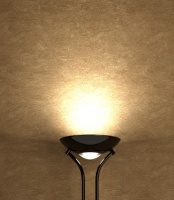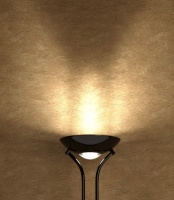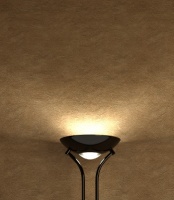Lighting
Area Lights and Mesh Lights
The most common way of lighting in LuxCoreRender is by using area lights. With this light you are able to simulate a wide range of lighting. It supports common settings such as power and color but also spread angle, opacity and laser.
Another common way is by using mesh lights. This type of light supports the same features as area lights, except laser, but also features textured lighting. As mesh lights are objects, you can assign an entire object to emit light, such as the tungsten filament in a light bulb or halogen bulb. In general, it's advised to use mesh lights with as few faces as possible to keep render times down.
Objects only emit light in the direction that the normals of the object's faces are pointing.
Environment Lighting
Environment lighting encloses the scene entirely, lighting it from all angles. It is normally used for environment mapping, although it can also be used to add a solid color environment. LuxCoreRender accepts both latlong and angular (light probe) environment maps.
Environment lighting is usually done with HDR(high dynamic range) images but it is possible to use low dynamic range images (like JPG or PNG) as well, but in this case you may want to add some additional lighting to your scene to avoid getting a poorly contrast render. This is not necessary with HDR environment maps, which can be used as the only source of light to create a realistic lighting.
You can find a lot of free quality HDR maps on the web by looking for "hdr maps"/"hdri maps" or "light probes".
For more information on environment mapping, see the Environment map page
Sun and Sky
The sun and sky light creates a lighting setup that simulates the light of the sun and atmosphere, based on the direction of a sun light in the scene and a parameter named turbidity which defines the clearness of the sky. Both the sun angle and the sky clearness influence the color of the light.
The intensity of the light can be set with the gain parameter. This is useful in scenes where the sun and sky light is combined with area/mesh lights. Note that the sun lamp is very bright(as it is in real life) so you may have to turn it way down if combined with other lights. The other lights may look like they are not even emitting, but they are actually overpowered by the sun.
If you want softer shadows try adjusting the relative sun size parameter.
It is possible to use this light with only the sky, or only the sun.
Point Lights
Point lights are infinitely small light sources that emit light in all directions. Apart from their location, the only available setting is color, which can also be used to regulate intensity.
In most cases, it's recommended to use only mesh/area lights and environmental lighting for your scene, rather than point or spot lights. This is because the point and spot lights have no real world equivalent as the light source is an infinitely small point. As a result, they tend to produce unnaturally hard lighting and sharp shadows.
Spot Lights
Spot lights are infinitely small lights that emit light in a cone shape. Apart from color and location, the width of the cone can be set (as the number of degrees of the center line it will extend), and there is a setting to feather the intensity towards the edge.
As with the point lights, it's recommended to use only mesh/area lights and environmental lighting. This is because the point and spot lights have no real world equivalent as the light source is an infinitely small point.
Projector
Both point lights and spot lights can distribute their light and color according to an image. With spot lights, this results in an effect like something being projected from a diapositive projector or beamer. With point lights, the image map is spherically mapped. <-- check if this works in luxcore
IES data
With the help of IES files you can get the light distribution pattern of a real light fixture. This will keep render times down as you don't need a reflector or glass material to replicate the pattern. The renders below were lit with the same area light, only with different IES files. Some links to IES files can be found on the external resources page. More information about IES files and how to create your own can be found here: Lighting_With_IES_Files



